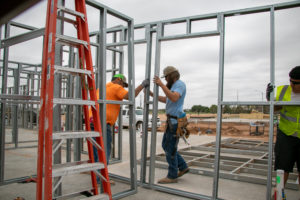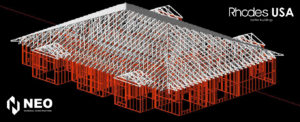Why CFS in the Most Sustainable Solution in Construction
As construction demand rises and material costs rise, owners and developers are looking for ways to cut costs without sacrificing quality. Wood was once the most popular building material because it was readily available and there was little research into the environmental impact of using this natural resource. However, modern times have shone a bright light on the timber industry, revealing that up to seven billion trees are lost to deforestation each year in support of traditional building practices.
Today, an increasing number of businesses are turning to alternative construction materials to help mitigate these staggering fingers and reduce our impact on the planet’s limited natural resources. Cold-Formed steel is one of those alternative materials that has quickly risen to the top, distinguishing itself from the rest due to its superior qualities (CFS). Steel is not only environmentally friendly but also durable and cost-effective, making it the construction industry’s true “VIP” and preferred material.
WHAT IS THE CFS ADVANTAGE AND HOW CAN YOU BENEFIT FROM IT?
This material is regarded as the most important construction and engineering material, with applications ranging from automobiles and refrigerators to cargo ships and buildings and everything in between. This type of construction produces the least amount of carbon emissions and waste, which has a positive impact on nearby resources. As we move into a more environmentally progressive world, CFS is widely regarded as the clear choice for the future of construction.
Steel, whether used for a large or small project, ensures that the structure will last for many years. It is regarded as the best material for structural framing foundations in terms of safety and durability. With the highest strength-to-weight ratio of any construction material, it provides superior structural integrity with less material and weight, lowering cost, labor, and schedule. It is a low-maintenance and long-lasting material that will ultimately result in fewer repairs and lower carbon emissions.

Reduces Energy Cost
Steel has the benefit of being easily insulated, lowering energy bills, and saving money. When we use less energy, we not only lower our living costs but also help the environment.
These energy savings translate into faster project completion, resulting in less waste throughout the construction process. Steel can significantly speed up construction, up to 50% faster than wood and 50% faster than concrete. Companies can save energy by increasing construction speeds, which saves money. These savings are passed on to the consumer, reducing their wait time to enter their newly constructed building and assisting in the avoidance of unnecessary expenditures.
Resists the Elements
Steel has the added benefit of being an extremely durable material that can withstand harsh weather. Natural disasters such as earthquakes, fires, flooding, hurricanes, and seasonal pest control can all have a significant impact on the livelihood of buildings made of traditional wood materials.
Reduced Waste
Because many companies manufacture their products to order, steel production produces far less waste than other building materials. The ability to produce only the amount of product required for a project eliminates unnecessary manufacturing emissions, waste from leftover materials, and gas consumption from transporting heavier than necessary loads. Approximately 30% of construction materials on a typical job site go unused and waste, resulting in approximately 145 million tons of new waste entering our landfills each year. Steel as a customizable material not only reduces waste, but any unused product can be easily recycled and repurposed. It’s clear that using steel is the best option for both the environment and the consumer.
These scraps are generated during the fabrication process when each individual component is cut to length, fastener holes are pre-notched and swaged, pre-notched, and prepared for assembly. The scrap steel is collected for recycling companies like intellectual are conscious and deliberate about how they handle waste on and off-site, resulting in a company in a completely sustainable construction environment and eco-friendly process not found with any other traditional construction material, means, or method.
Lower Environmental Impact
Steel is an excellent construction material for many reasons, one of the most important being its low environmental impact. The deforestation sector contributes significantly to global carbon emissions, accounting for up 10% of total emissions released into the environment. These high carbon releases are caused not only by the pollutants emitted by the vehicle used to fell the trees but also by the high carbon concentration released when the trees die. Forests are important carbon sinks, meaning they absorb carbon dioxide in the atmosphere and emit clean air. However, when they are cut down during deforestation, the carbon stored within each tree is released back into the atmosphere, significantly increasing emissions.
Cost Effectiveness
Using a company that fabricates steel to order significantly reduces overhead costs, passing the savings on to the consumer. Steel’s long lifespan eliminates the need for future replacement or reconstruction, saving significant money in the long run. Furthermore, because of the ability to use recycled materials in the manufacturing process, steel costs remain lower than many other materials, preserving its value in the face of extreme market volatility. When steel is used as the primary building material, the structure can withstand more weather phenomena, lowering the cost of repairs, building maintenance, and severe weather incidents. All these examples ass up to the money saved, making steel the superior, cost-effective choice.

Design Flexibility
Companies that use on-site precision manufacturing equipment have unprecedented design flexibility. Unlike wood, CFS studs, beams, walls, trusses, joists, and headers can be formed as needed, allowing the architect to make last-minute structural changes without incurring additional time and costs. This unique flexibility opens many construction possibilities, reducing the time and cost associated with unexpected construction issues.
SOURCES:

Legal
Outreach & Investment
Office/Plant Location
Reese Technology Center Hanger 92
212 Davis Drive
Lubbock Texas 79416
Our Services
- Building Components
- Design Services
- Building Kits
- CFS Framing
- Light Gauge Steel Framing Manufacturer
- Prefabricated House Frame Supplier And Manufacturer
- Prefabricated Panel Manufacturer
- Metal Framing Designer and Supplier
- Steel Frames Design And Supply
- Prefabricated Metal Frames
- Prefabricated Steel Frames
- Prefabricated Housing And Panels
- FrameCAD Manufacturer And Supplier
- FrameCAD And BIM Design Services And Supply
- Metal Stud Framing Supplier
- Texas Metal Stud Framing Supplier